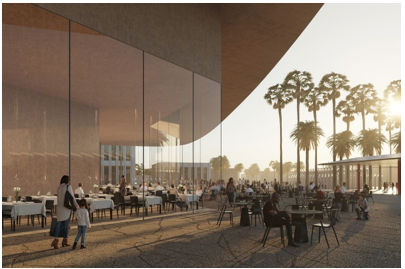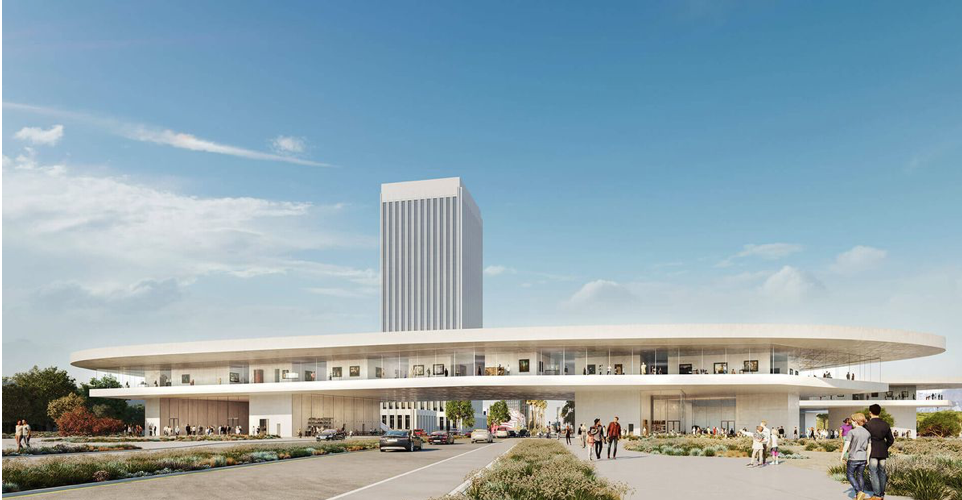CommentsNEIGHBORHOOD POLITICS--The following is excerpted from a letter sent by the Miracle Mile Residential Association to the Los Angeles County Board of Supervisors in advance of their vote on April 9, 2019 to certify the Final Environmental Impact Report (FEIR) for LACMA’s redo of the museum. The letter in its entirety can be read here.
Dear Supervisors: Since 1983, the Miracle Mile Residential Association (MMRA) has represented renters and property owners in the Miracle Mile. The MMRA has worked closely with the Miracle Mile Chamber of Commerce and the Miracle Mile Civic Coalition to make the Miracle Mile and Museum Row one of the most popular areas in Los Angeles.
The MMRA has specific concerns about the LACMA project that we will detail in this letter. But these concerns are overshadowed by our belief that the EIR for this project is fatally flawed. Both the Draft and the Final EIR are based on a “conceptual design” rather than on fully realized plans. Although, in an April 9, 2019 letter to the Los Angeles County Board of Supervisors, the County CEO acknowledges that schematic and design development drawings have been completed, these documents have not been shared with the public. Without these essential elements in hand the real price for what might be built cannot be determined, nor is there any way to assess the entirety of the project itself.
As the Final EIR now stands, the question of reasonable or realistic alternatives is impossible to answer, as well. Moreover, neither the Draft or Final EIR contains interior plans for the project, which makes it difficult to accurately determine how much usable square footage will actually be available for exhibition space or other uses.
Elements of the geological and acoustical studies for this project defy or ignore the common-sense experiences of Miracle Mile residents, whether it be the constant tar and oil seepage in this area or the noise disturbances from nighttime events at the museum. The number of days that “Full” signs are posted outside LACMA’s current parking facilities makes a mockery of the EIRs assertions that the project, with its shared parking plan with the Academy Museum, has sufficient parking. And the FEIR makes no mention of the County of Los Angeles code parking requirements for the new museum project. For these and other reasons, we feel that the EIR should be re-circulated so that the true impacts of this project can be calculated.
As it exists in the FEIR, there are many aspects of the project that we believe are not properly mitigated – or adequately explained – that will have an extremely negative impact not only on our community but on LACMA’s future as a major metropolitan museum.
Before we state our reservations, we’d like to make abundantly clear that the MMRA does not oppose LACMA expansion or a new LACMA structure. Indeed, our organization wants to see Wilshire Boulevard blossom to its full potential as a center of art, commerce, and life – as it was envisioned nearly 100 years ago by A.W. Ross. We strongly believe LACMA has a significant place in the future of our neighborhood.
 But, we are very troubled by LACMA’s dogged determination to replace the existing campus with a single-story elevated structure that spans Wilshire Boulevard. LACMA Director Michael Govan insists that arts patrons will not climb above the first floor of a museum. That, and only that, has been his rationale for the costly bridge design whose price tag keeps climbing even as the project keeps shrinking.
But, we are very troubled by LACMA’s dogged determination to replace the existing campus with a single-story elevated structure that spans Wilshire Boulevard. LACMA Director Michael Govan insists that arts patrons will not climb above the first floor of a museum. That, and only that, has been his rationale for the costly bridge design whose price tag keeps climbing even as the project keeps shrinking.
The extremely high price of the project is not commensurate with its purported benefits – particularly as it will reduce existing museum space by at least 45,000 square feet (and by some estimates, double that loss). In essence, LACMA will be spending more for less. No major museum in history has embarked upon such a backward mission. It defies logic for the largest encyclopedic art museum west of the Mississippi to purposely shrink not only its exhibition space but to eliminate the office and support space that is part and parcel of the routine operation of a museum.
By bridging Wilshire Boulevard this unusual structure thrusts the museum into a densely populated and historically protected residential area. This building, raised above the ground on enormous pylons and crossing Wilshire with a 150-foot-long by 170-foot-wide bridge, will make future expansion impossible. There will be no way to add onto the building, either up or out. Utilizing concrete to construct gallery walls, as is contemplated by the new plan, will completely inhibit any future rearrangement of exhibition space (which is also shrinking by one-third). LACMA will be a museum locked out of its own future.
The inherent limitations of this design will also compel LACMA to lease five floors of nearby office space at market-rates in order to properly function – not to mention leasing additional off-site locations to serve other key museum activities. The debt service on the construction costs of the project plus the ongoing operating costs to lease off-site spaces to accommodate the proper operation of the museum will be a substantial financial burden on LACMA for decades to come. This will obviously strain and hamper the museum’s ability to fund its important work as a major center of art and culture.
This scenario was specifically one LACMA meant to avoid when it first acquired the Spaulding Lot on the south side of Wilshire, where a portion of the new museum will be built. This parcel is an extremely valuable site with no height limit for skyscraper development. LACMA bought the land in the first place as a land bank to cash in on development rights – to build precisely the kind of development the city and county are looking for along this transit-rich corridor. Now LACMA will lose perhaps its greatest resource: Land capable of generating a revenue stream that likely would have added millions annually to LACMA’s coffers, rather than, as the present proposition does, indebt the museum further.
This is of great concern to us as taxpayers. LACMA receives an annual $29-million subsidy from Los Angeles County – the largest annual taxpayer contribution received by any museum in the United States. Museum Associates has a 99-year ironclad agreement with the County that mandates that this annual contribution can be reduced only if there is a financial emergency that forces the county to lay off 2% or more of its full-time employees. This agreement also guarantees that LACMA receives annual raises from the county that are equivalent to the rate of inflation (up to a ceiling of 5% per year).
As well as this annual subsidy, the County of Los Angeles will contribute $125 million toward the construction of this project, which will be funded by means of a 30-year bond that will cost the taxpayers approximately $213 million (or $7 million per year). The County will also provide collateral in the form of County-owned real estate for a $300 million bond with 30-year maturity issued on the County’s credit to be repaid by Museum Associates at a cost of an estimated $17.5 million per year (for a total of approximately $526 million).
The County will be pledging $425 million of public assets for this project but doing so without Museum Associates possessing all the $650 million they say is necessary to complete the project. According to the County CEO, of the $433 million in pledges that LACMA has solicited to date, only $82 million has been collected. This raises alarms as it seems that – despite their assurances to the County otherwise –LACMA is taking a “shovel in the ground” approach with the intent of returning to the County for additional funds and/or funding guarantees to complete the project or to cover the cost of construction budget overruns.
Given the budget overruns and construction delays for the nearby Academy Museum – which also features an unusual, expensive, and difficult to build design – we are very apprehensive that the LACMA project will not be built on budget or on time.
The County of Los Angeles has committed many millions of dollars to deal with a great number of critical public issues – from improving mental health services and combatting homelessness to the construction of new jail facilities. We urge the Board of Supervisors to conduct a rigorous cost-benefit analysis of this proposed project as we believe that the rationale for this design is ambiguous and unrealistic, and will permanently damage the function of one of Los Angeles’ greatest cultural resources.
After such a review, should the County deem the project fiscally sound and architecturally suitable, we still urge an abundance of caution and prudence in committing taxpayer funds without guarantees from Museum Associates that they have in hand all the money needed to build this project. Finally, no matter what, Museum Associates must provide additional assurances to the public that they will not be returning to the County for additional financial assistance for this project. The generosity of the taxpayers of Los Angeles County must not be taken for granted or taken advantage of in the public financing of this project.
(The Miracle Mile Residential Association is located roughly between La Brea and Fairfax and San Vicente and 8th Street. Jim O’Sullivan is the MMRA president.)
-cw













